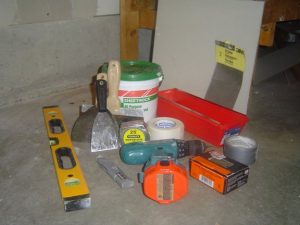The Secret to Removing Drywall from a Room is to Minimize the Creation of Dust
By Mark J. Donovan
|
|
There are a number of cases where I’ve needed to remove drywall from a wall or an entire room. Contrary to what you may have seen on various home remodeling television shows, using a sledge hammer to bash out drywall is not the smartest method. Not unless you don’t care about preserving walls studs, wiring, plumbing and creating a lot of dust.
Over the years I’ve found the best way to remove drywall from walls is to use a jab saw. A jab saw is a hand saw that you plunge into the drywall and slide repetitively in and out to cut the drywall. The best place to plunge in the saw is near an expected wall stud. You can then use the wall stud to guide the saw as you cut the drywall. This way you can maintain straight vertical cuts with the saw. |
Using a jab saw also helps mitigate drywall dust. Do not plan to use a power saw to cut drywall as it will blow dust all over the room and home.
Once you’ve cut out the section back to the wall stud edges use a carpenters square and a utility knife to cut back the drywall halfway over the wall studs. This will give you a nailing surface to install the drywall patch panel. Make sure to use a sharp utility knife so that you don’t tear the drywall paper.
| Also, use a rasp to smooth out any ruff edges on the cut drywall patch panel so that the piece fits nicely into the rough opening you cut in the wall.
Other “nice-to-have” drywall tools include a drywall lift, a drywall banjo and a router with a special cutting bit. Drywall lifts help to place and attach drywall onto ceilings. A drywall banjo helps in the application of drywall tape and joint compound to the seams, however these tools take a little practice. A router is ideal for cutting out holes for electrical outlets and switches. |
 |
So before you embark on a drywall project make sure you purchase the right drywall tools first.
For information on repairing a large drywall hole, see the “How to Repair a Large Drywall Hole” Ebook from HomeAdditionPlus.com. The “How to Repair a Large Drywall Hole” Ebook provides step-by-step instructions on how to repair your damaged wall so that it looks as good as new.
See HomeAdditionPlus.com’s Drywall Calculator
Related Information
- How to Repair a Drywall Tape Seam
- How to Make Large Drywall Hole Repairs
- How to Fix Holes in Sheetrock Walls
Additional Drywall Installation Resources from Amazon.com
 |
 |
Free Home Addition Price Quotes with No Obligation!
Fill out our 3-5 minute quick and easy form, and receive a free price quote on a house addition from one of our prescreened and licensed home addition contractors. This process is free and there is no obligation to continue once you receive your house addition price estimate.

